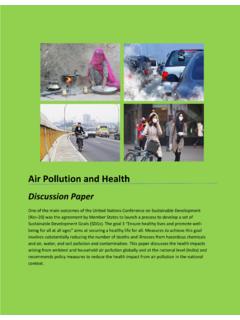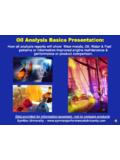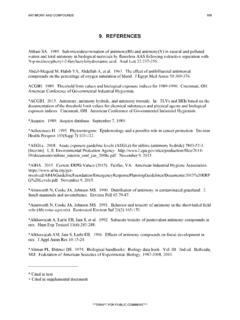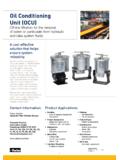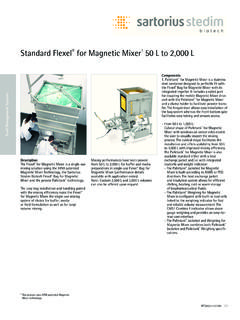Transcription of Particulate Matter in Injectable Drug Products
1 The most recent version at doi: 186-20067, 2013 PDA J Pharm Sci and Tech Stephen E. Langille Particulate Matter in Injectable drug Products on July 1, from on July 1, from REVIEWP articulate Matter in Injectable drug ProductsSTEPHEN E. LANGILLE, *Office of Pharmaceutical Science Center for drug Evaluation and Research Food and drug Administration 10903 New Hampshire Ave, Bldg. 51, Rm. 4158 Silver Spring, MD 20993 PDA, Inc. 2013 ABSTRACT:Clinicians have had concerns about Particulate Matter contamination of Injectable drug Products sincethe development of the earliest intravenous therapeutics. All parenteral Products contain Particulate Matter , andparticulate Matter contamination still has the potential to cause harm to patients.
2 With tens of millions of doses ofinjectable drug Products administered in the United States each year, it is critical to understand the types and sourcesof Particulate Matter that contaminate Injectable drug Products , the possible effects of injected Particulate Matter onpatients, and the current state of regulations and standards related to Particulate Matter in Injectable drug , the goal of manufacturers, regulators, and standards-setting organizations should be to continue to minimizethe risk of particle-induced sequelae, especially in high-risk patients, without trading unnecessary manufacturingburden for minimal safety : Injectable , Parenteral, Particulate Matter , Pharmaceutical quality, Current good manufacturing practice(cGMP).
3 LAY ABSTRACT:All Injectable drug Products are contaminated with some level of solid Particulate Matter , including,for example, fibers, dust, rubber, and silicone. These materials enter drug Products primarily during the manufacturingprocess. The possible effects on patients of Injectable drug Products containing Particulate Matter depend on a numberof factors. However, given the large number of patients receiving Injectable drug Products each year in the UnitedStates and the potential for Particulate Matter to cause harm to patients, it is critical to continue to minimize particulatematter contamination in Injectable drug Products . Manufacturing standards and regulations have helped improvemanufacturing quality.
4 Nevertheless, manufacturers, regulators, and standards-setting organizations must continue towork toward improving manufacturing quality and minimizing the risk of harm from particle contamination,especially in high-risk of the basic tenets of pharmaceutical quality is themanufacture of drug Products that are free of micro-bial, chemical, and physical contaminants. Althoughmicrobial contamination of Injectable drug Products isfairly well understood, defined, and measureable, itremains difficult to achieve Injectable drug productsthat are free of chemical and Particulate Matter con-tamination. This is due, in part, to the nature of con-taminants, the current state of pharmaceutical manu-facturing, and the availability of extremely sensitivemeasuring about the clinical use of Injectable drugscontaining Particulate Matter can be traced to theearliest intravenous fluid therapies employed in the1830s.
5 An Edinburgh physician named John Mackin-tosh, while developing methods of intravenous salineinfusions to treat victims of a cholera outbreak, rec-ommended that the solutions be strained twice throughleather rather than cotton or linen, which could allow minute portions of flakey threads to be injected intothe patient (1). Although processing and filtrationtechnologies for intravenous injections have evolvedexponentially in the years since, concerns about thepotential effects of injected Particulate Matter on pa-* Corresponding Author: Stephen E. Langille, ,Office of Pharmaceutical Science Center for DrugEvaluation and Research Food and drug Administra-tion 10903 New Hampshire Ave, Bldg.
6 51, Rm. 4158 Silver Spring, MD 20993. Telephone: 301-796-1557,e-mail: Journal of Pharmaceutical Science and Technology on July 1, from tients continue, especially given the equally exponen-tial growth in the number of patients who could to the American Hospital Association, admitted 37,479,709 patients in 2009 (2).Assuming an average intravenous solution administra-tion of 5 L per patient (3), nearly 190 million L ofintravenous fluid are administered annually. Giventhese data, an accurate assessment is warranted of thefactors causing Particulate Matter contamination ofdrug Products , the patient risks associated with theadministration of such contaminated drug Products ,and the current state of regulations and standards thatprovide the framework for achieving article describes some of the sources of particu-late Matter contamination in Injectable drugs and thepossible clinical effects that can result from suchcontamination.
7 The article also reviews the develop-ment of standards and regulations to control contam-ination of Injectable Products and offers some prelim-inary next steps for manufacturers, regulators, andstandards-setting organizations who are working to-gether to ensure patient and Sources of Particulate MatterChapter 788 of the United States Pharmacopeia(USP), Particulate Matter in Injections (4), definesparticulate matteras mobile undissolved particles,other than gas bubbles, unintentionally present in thesolutions . Groves (5) divided Injectable drug partic-ulate Matter into two classes based on the source of theparticulate Matter :intrinsic particles, defined as thoseoriginally associated with the solution that were eithernot removed by filtration or precipitated out of thesolution, andextrinsic particles, defined as those thatenter the container or solution during Chapter 1788 Methods for the Determinationof Particulate Matter in Injections and OphthalmicSolutions (6) provides similar, but more specific, def-initions, classifyingextrinsicparticulate Matter as ad-ditive, foreign, unchanging, and not part of the formu-lation, package or assembly process.
8 It classifiesintrinsicparticulate Matter as associated with thepackage, formulation and/or assembly process and ca-pable of change upon aging . USP Chapter 1788 also notes that intrinsic Particulate Matter is not thesame asinherentproduct characteristics such as thehaze, coloration, or known populations of small par-ticles common to certain high-concentration proteinformulations. This inherent particle category also in-cludes the normal particle size distribution of activepharmaceutical ingredients in suspensions and othercommon delivery forms ( , emulsions, lipids, etc.).Inherent particles or properties, when consistent andexpected, may be completely are five general sources of Particulate Matter ininjectable drug Products : the environment, packagingmaterials, solution and formulation components, prod-uct packaging interactions, and process-generated par-ticles.
9 Proper product development and appropriatemanufacturing and packaging process design can suc-cessfully exclude Particulate Matter sourced from fourof the five categories. The fifth category, particulatematter sourced from the environment, can be excludedonly by use of highly controlled filling areas, ratherthan by an intimate understanding of the product ,process, and container closure system. A list of poten-tial particle contaminants, their sources, and intrinsic/extrinsic natures as defined by USP Chapter 1788 is presented in Table that certain types of Particulate Matter , includ-ing metal and glass, may be either intrinsic orextrinsic depending on the point at which they enterthe container.
10 For example, glass particles can enterthe manufacturing process from the outside (extrin-sic, , through the use of broken or poorly washedincoming vials) or come from inside the containerthrough degradative change during product storageor from process-related glass breakage events (in-trinsic, , lamellae, tunnel/oven, or during fill-ing). Likewise, metal particles can come from thecontainers, the manufacturing environment (extrin-sic, , building materials), or the manufacturingprocess (intrinsic, , blending equipment). Evenparticle levels that meet compendial or companytarget limits can be of concern. For example, so-calledpoint-source contamination,which is the pre-domination of one particle type (7), may indicatethe presence of process contribution or packageinstability that requires investigation and remedia-tion.
